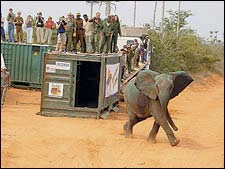September 2002
By JOSHUA BROCKMAN
On paper, Angola’s 12 national parks and reserves take up 31,600 square miles—roughly 7 percent of the country. The problem is, no one really knows how many animals are still roaming around in them. Now, given the recent cease-fire, wildlife biologists are eager to get back in there and see what has survived. The entry point is Quiçama National Park, 44 miles south of Luanda.
“This park used to have more than 4,000 elephants, 6,000 forest buffaloes, and numerous other wildlife, but it was all destroyed,” laments Wouter van Hoven, 54, a professor at the University of Pretoria’s Centre for Wildlife Management. Van Hoven heads the Kissama Foundation, a conservation group formed by the Angolan government in 1996 to resuscitate the country’s park system.

An elephant takes its first steps inside Quicama National Park.
To repopulate Quiçama, the foundation launched Operation Noah’s Ark. Since 2000, 34 elephants, 14 zebras, four giraffes, 18 ostriches, and 12 each of Livingston eland, kudu, and blue wildebeests have been airlifted from neighboring Botswana and South Africa. Next June, van Hoven plans to make history with the largest international wildlife relocation ever attempted: 200 elephants and about 200 other animals riding first-class aboard a South African navy supply ship. Quiçama is also slouching towards eco-tourism: It’s got the only game lodge currently functioning in Angola and a contingent of 60 former soldiers who have been retrained as game wardens.
This August, van Hoven and Richard Estes, a research associate with the Smithsonian Conservation and Research Center, plan to lead an expedition to survey Luando Integral Nature Reserve and Cangandala National Park for any sign of the rare giant sable antelope, Angola’s equivalent of the bald eagle. The former commander of the Angolan army also will be along to steer them clear of minefields. “I don’t think they’re all wiped out,” says van Hoven of the sable, which remains prized by poachers for its long, curved horns. “But we want to make sure that this animal does not go extinct.”
© Outside
